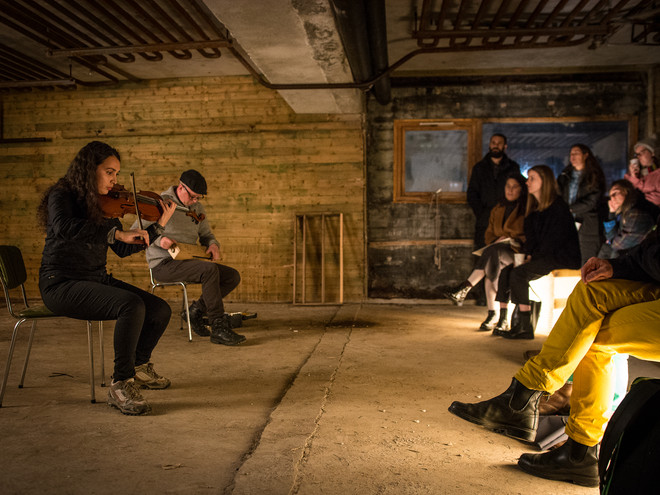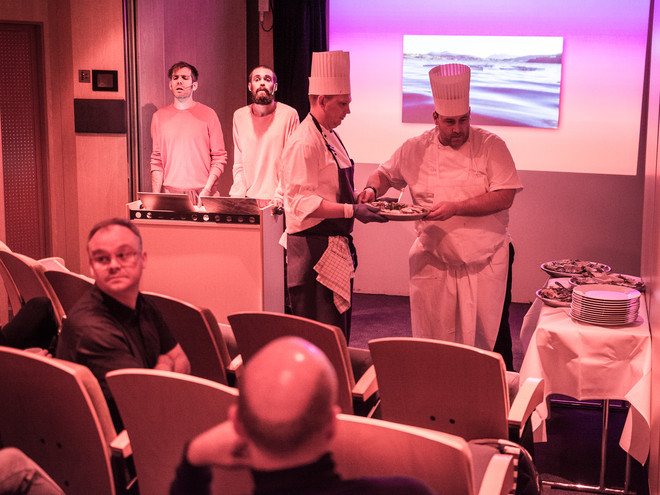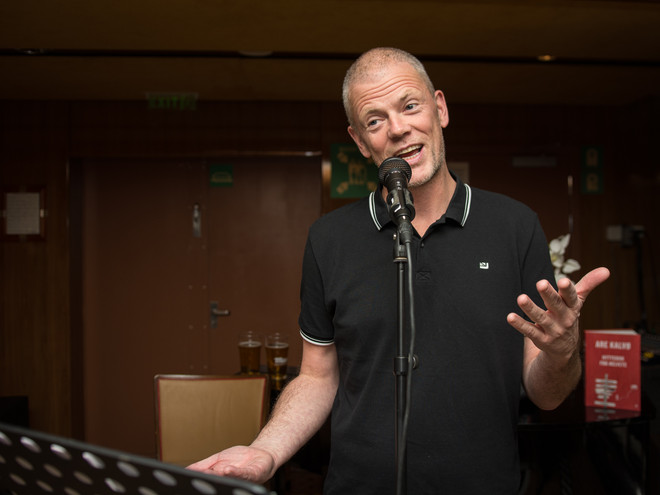Artists and Speakers 2018
Rugged, weathered, above the sea / Furet, værbitt, over vannet built upon the romantic pictorial and literary construction of Norway through its landscape to question the enduring depiction of an untouched and limitless territory: a depiction at odds with the country’s oil production boom and its intensive fish farming industry.
Curated by Charles Aubin, in dialogue with artistic director Tanja Sæter.
Film program curated by Rhea Dall, in dialogue with Charles Aubin.
Other curatorial contributions and presentation of artists in this program was by Galleri KNIPSU, Bergen Art Book Fair, Rogaland Art Center, The North Norwegian Art Center (NNKS) and the Sami Center for Contemporary Art.
Locations: Svolvær and Kvalnes in Lofoten, Hurtigruten (a ship), Trondheim and Bergen.

Hanan Benammar and Espen Sommer Eide
Black-legged Kittiwake (Nusfjord 4/09/2018)
Sound performance in Svolvær, Lofoten.
The voice of the black-legged seagull is a characteristic, mewing “kitti-wake”, from which its English name is derived. During a field-recording journey in Lofoten in September 2018, artists Hanan Benammar and Espen Sommer Eide recorded the remaining small population of black-legged kittiwakes living in Nusfjord. Due to environmental changes, the population is in rapid decline, and is estimated to be extinct within the next decade.

Sissel Mutale Bergh
Speakersystem performance including a map, filmscreening and artist talk with Arnisa Zeqo.
In 2015, Sissel M. Bergh initiated a five-year experimental documentary film project titled knowhowknow that collects traces of Sámi culture along the coast of Møre and Trøndelag, around the city of Trondheim. For Rugged, weathered, above the sea, Bergh infiltrates the ship’s speaker system and, as we sail down the coast, enumerates the Sámi names and forgotten memories of the places seen from the boat.
Sissel M. Bergh was presented by Sami Daiddaguovddas / The Sami Center for Contemporary Art and Director Kristoffer Dolmen.

Siri Borge
Cabin installation.
Siri Borge draws on her Resting Cod Face installation series to present a new iteration that plays with the Norwegian popular foodstuff of locally produced canned sardines called “iddis”. Borge, a native of Stavanger, the oil capital of Norway, refashions the usually traditional and outmoded label imagery to give them a contemporary makeover that addresses changes in local and national identities.
Siri Borge’s installation was presented by Rogaland Kunstsenter and curated by Geir Haraldseth.

Cooking Sections - Daniel Fernández Pascual and Alon Schwabe
CLIMAVORE: On Tidal Zones & The Empire Remains Shop
2 x Lecture-performances, panel debate and book launch.
Human-induced climatic alterations of the oceans, the recent appearance of new parasites, and the disappearance of species could all be addressed through a different form of eating and sourcing of nutrients. This lecture-performance by London-based duo Cooking Sections (Daniel Fernández Pascual and Alon Schwabe) addresses the denuding of landscapes resulting from seawater pollution by intensive fish farming.

Marthe Ramm Fortun
Seeing is Turning
Performance.
For Rugged, weathered, above the sea, Marthe Ramm Fortun creates a performance triptych that unfolds during the journey on the Hurtigruten. Involving site-specific paintings, daily ephemeral actions in different locations on the boat, and a pamphlet handed out to the public, Seeing is Turning seeks to challenge the gendered assumptions associated with the depiction of the Norwegian landscape. Channeling the ghosts of tapestry artist Frida Hansen and landscape painter Kitty Kielland, Fortun offers an alternative, more personal and unambiguously feminist account of the Norwegian wilderness.

Ina Hagen
Spoken-word performance.
Ina Hagen presented a new spoken-word performance based on her current research in Brazil that explores the country’s complex economical and environmental intertwinement with Norway. Hagens work explores layers of mediation between audiences, artwork, and artists, in order to create instances of collective, critical reflection. This is often done by use of performative situations or platforms for social thinking.

Daisuke Kosugi
Lecture performance.
Daisuke Kosugi presented a new lecture-performance that expanded on the material gathered for his new film.
In film, sculpture, performance, and text, Kosugi constructs seductive scenarios that explore the underlying conflict between overarching social systems and personal agency. Whether by portraying how creativity is mined by the “creative industry” in a Post-Fordist labour market, or through a narrative of creativity that is not convertible to economic or cultural measures of productivity, Kosugi examines these struggles through the lives of individuals

Janike Kampevold Larsen
Personal reflections.
Based on her extensive travels to Svalbard, Bjørnøya, and the Barents Sea coast, Janike Kampevold Larsen gives a personal reflection on the role of Arctic materialities such as rocks, sand, ice, and snow. If the region is portrayed as desolate, unproductive, and cold, it is all the more easier for industries to take control of it.

Marit Paasche
Outrage in Order
Lecture about Hannah Ryggen.
The self-taught Swedish-born Norwegian textile artist Hannah Ryggen (1894-1970) left behind an impressive array of works in which she determinedly paid no mind to conventional distinctions between art, craft, politics, and life.
Marit Paasche’s lecture was co-presented with NORLA – Norwegian Literature Abroad and combined with a visit to the Hannah Ryggen collection at The Nordenfjeldske Museum for Arts and Crafts.

Hanne Beate Ueland
Kitty Kielland’s Norwegian Landscapes
Lecture and Opening Remarks
The Opening Remarks by Hanne Beate Ueland, Director of Stavanger Art Museum, for Rugged, weathered, above the sea map the terrain of the Norwegian landscape painting in the late 19th century, including Peder Balke, Johan Christian Dahl, and Hans Gude. Who were these artists and how where they connected? What were the political and scientific developments that helped them broaden the artistic depiction of the landscape in this period so crucial to the establishment of a Norwegian state? How was landscape woven into the fabric of a national identity?

Are Kalvø
Hyttebok fra helvete / Cabin Book from Hell
Standup comedy.
Are Kalvøs latest book tackles the relationship Norwegians entertain towards nature. Although his main character grew up in a typical Norwegian context – hiking in fjords and mountains – he never really became a “man of nature”.
Are Kalvø was co-presented in collaboration with NORLA – Norwegian Literature Abroad.

Anne Karin Jortveit
Index for a place of no importance
Cabin installation.
Anne Karin Jortveit dyes and spins her own wool with local plants, sometimes selecting them for their supposedly “threatening” or “invasive” qualities. Lupins (lupin), warty cabbage (russekål), goldenrod (kanadagullris), beach rose (rynkerose), and yellow loosestrife (fagerfredløs) are the most recent specimens Jortveit has incorporated into her various coloring processes. Many of them bear valued properties for either herbal medicine, culinary qualities, or permacultural design, but these attributes are often overshadowed, or even forgotten.

Søssa Jørgensen
Ættesang (Song of Kin)
Performance and screening.
Ættesang (Song of Kin) was written as a stream of consciousness in response to Section 2 of the “Norwegian Marine Resources Act” of 2008. The words in Ættesang (Song of Kin) constitute a network of myths, conventions, deeds, and memories. The flow of speech glides over micro and macro levels related to the use of resources from the known and unknown depths of the ocean.
Søssa Jørgensen was co-presented in collaboration with Galleri KNIPSU.

LCLA office
Big Boat, Small Town
Light performance.
At night, Oslo-based Swedish-Columbian architecture firm LCLA office (Charlotte Hansson and Luis Callejas) uses lights to isolate, highlight, and emphasize the geological features of the Norwegian coast as seen from the boat’s observatory deck. Operating the vessel’s lighting system, the duo outlines the dramatic mountains, islands, and fjords, while abstracting them in a subtle game of perception.

Christian Tunge
Bluetooth Boogie
Participatory installation.
Christian Tunge set up a temporary interactive postcard stand made up of the passengers own touristic photographs taken on board.
Acting as a meeting place for Coast Contemporary’s participants as well as the cruise’s passengers at large, Bluetooth Boogie was updated regularly throughout the journey with new images of events on the ship, landscape photos, and passengers’ personal snapshots.

Randi Nygård in conversation with Timotheus Vermeulen
The Wild Living Marine Resources Belong to Society as a Whole
Artist talk.
Does nature have other inherent values than potentially being a resource for us to use? Is society part of the ecosystem or the ecosystem part of society? Is it necessary to view ourselves as being outside of nature in order to manage it? Artist Randi Nygård reflects on her book The Wild Living Marine Resources Belong to Society as a Whole, in a conversation led by writer Timotheus Vermeulen.
Randi Nygård was the winner of our first Coast Contemporary Art Prize in 2018, granted in collaboration with Oslo Open.

Monica Winther
Lost in Paradise
Vocal Performance at the North Norwegian Art Centre in Svolvær, Lofoten.
Monica Winther presented Lost in Paradise, a vocal performance expanding on her research at the intersection of sound art and horticulture. As both an artist and a gardener, she has progressively, over the past years, included horticultural strategies in her work.
Monica Winthers performance was presented by the North Norwegian Art Centre and curator Karolin Tampere.